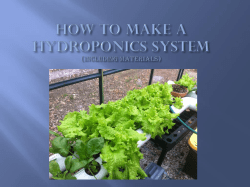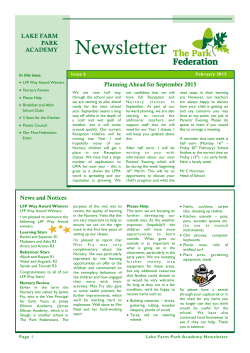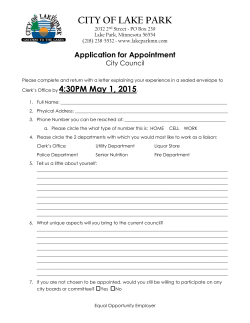
2015 Plant Market Update
PLANT MARKET UPDATE By Timothee Sallin April 2015 President, Cherry Lake Tree Farm A s the housing market has recovered, the growth in demand for ornamental trees, palms and shrubs has outpaced the growth in supply. This has led to rapid escalations in plant material prices, limited availability and smaller specifications. Today, as we take stock of the current market conditions and look forward to the next 12 months, it appears that the plant material shortage will continue to be felt throughout 2015 and will be more severe in its impacts as we move through Spring and into the Summer. CHERRY LAKE TREE FARM PLANT MARKET UPDATE 2015 | 1 HOUSING STARTS The key driver of demand for plant material is new construction and in particular new housing starts. Florida housing starts have been recovering since 2010. In 2013 Florida housing starts were 124% higher than 2011. 2014 starts remained steady at 85K units, and the first quarter of 2015 indicates that more growth can be expected this year.1 Texas, likewise, has been experiencing strong housing growths since 2010. Housing starts in Texas have grown from 83,840 in 2010 to 130K in 2012, 147K in 2013 and 165K in 2014.2 Globally, the same pattern of housing recovery can be seen at the South Census Region level, which represents the majority of the market for Florida grown nursery trees, palms and shrubs.3 South Census Region States Units on graphs expressed in monthly totals. 1 US. Bureau of the Census, New Private Housing Units Authorized By Building Permit for Florida [FLBPPRIV], retrieved from FRED, Federal Reserve Bank of St. Louis https://research.stlouisfed.org/fred2/series/FLBPPRIV/, April 14, 2015. 2 US. Bureau of the Census, New Private Housing Units Authorized By Building Permit for Texas [TXBPPRIV], retrieved from FRED, Federal Reserve Bank of St. Louis https://research.stlouisfed.org/fred2/series/TXBPPRIV/, April 14, 2015 3 US. Bureau of the Census, New Private Housing Units Authorized By Building Permit for the South Census Region [CSOUBPPRIV], retrieved from FRED, Federal Reserve Bank of St. Louis https://research.stlouisfed.org/fred2/series/CSOUBPPRIV/, April 14, 2015. 2 | CHERRY LAKE TREE FARM PLANT MARKET UPDATE 2015 IMPACTS ON PRICING AND SPECIFICATIONS The plant material demand associated with these housing starts is driving nursery sales and leading to rapid escalations in plant material prices. The price of a 30 gallon Live Oak has increased from a low of $31 in 2011 to a current price of $107.4 Despite these major price increases, nursery supply is still unable to keep up with demand. Nurseries are selling out of inventory and releasing crops early to fulfill excess demand. This leads to smaller specifications as trees are sold before they are able to reach maturity. In the case of the 30 gallon Live Oak, trees were commonly sold at 2.75” - 3” caliper in 2011 due to the oversupply at the time- this was an inch over the industry standard of 2” caliper for a 30 gallon Live Oak.5 Today, due to the shortage, the same 30 gallon Live Oak is being sold at 1.5” - 1.75” caliper. In other words, the market is paying 245% more for a tree that is 50% smaller in 2015 compared to 2011. EVOLUTION OF PRICE FOR 30 GALLON LIVE OAK Year 2011 2012 2013 2014 2015 Price $31 $40 $68 $86 $107 Caliper 2.75 - 3” 2.75” 2.5” 2” 1.75” 119% 177% 245% % Price Increase 0% since 2011 28% EVOLUTION OF PRICE FOR 3” CALIPER CONTAINER LIVE OAK Year 2011 2012 2013 2014 2015 Price $31 $40 $96 $149 $222 Contianer Size 30g 30g 45g 45g 65g 28% 206% 374% 609% % Price Increase 0% since 2011 4 All Nursery stock pricing in this report is based on Cherry Lake Tree Farm average annual net sales price. 5 A 3” Caliper 30 Gallon is considered an overgrown tree and does not meet the Florida Grades and Standards. Nevertheless, the severity of the recession resulted in many overgrown trees making their way to market between 2010 and 2013. CHERRY LAKE TREE FARM PLANT MARKET UPDATE 2015 | 3 To better understand the full impact of the plant material shortage on prices, we need to compare the price of trees of equal caliper. To source a 3” caliper Live Oak in 2015, one must purchase a 65 gallon size container.6 The current price of a 65 gallon Live Oak is $222. Thus the price of 3” container live oak has increased from $31 in 2011 to $222 in 2015 which is over 600%. The price of 3” container live oak has increased from $31 in 2011 to $222 in 2015 which is over 600%. INDUSTRY IMPACTS Our industry is dealing with a historic shift in supply and demand. This shortage will likely persist for several more years as nursery stock cannot be produced at a faster rate than nature allows. Our prediction is that the shortage will become more severe over the next 12 months and last at least through the end of 2017. Nurseries have been the first to respond to these market transformations as they have been the first to feel the impact of these changes in their businesses. Most nurseries have new stricter selling policies to better manage their inventory. These include limiting access to their inventory to select customers, cutting off smaller accounts, limiting credit availability, imposing minimum and maximum quantity limits on orders, and insisting that orders ship immediately, limiting customers’ ability to hold inventory for future projects. Our prediction is that the shortage will become more severe over the next 12 months and last at least through the end of 2017. Landscape contractors have, in turn, had to make changes to their bidding and procurement strategies, incorporating plant material escalations into their bids and qualifying proposals to protect them against availability and pricing risk. Savvy landscape contractors are seeking to procure plant material as early as possible and securing material before committing to a project. 6 Today some crops of 65 gallon live oaks are selling at 2.5-2.75” caliper and it is likely that 3” caliper live Oaks will become scarce even in the 65 gallon container size. 4 | CHERRY LAKE TREE FARM PLANT MARKET UPDATE 2015 CONSTRUCTION PROJECT IMPACTS Plant material shortages pose serious threats to construction projects affecting budget, schedule and quality. Landscape installation is typically at the end of the construction schedule and one of the last items to be completed before a project can obtain a certificate of occupancy. The plant material shortage can affect the schedule in several ways. Generally, longer lead times for materials increase the risk of schedule delays. Difficulties sourcing material can prompt the contractor to request approval of alternates which cost time and may in turn require that plans be re-submitted for permitting. Additionally, there are greater chances that material will fail mandatory inspections due to specification or quality causing further delays. Project quality is also at risk. By definition, the shortage means there are fewer sources of quality plant material. Projects will be impacted as contractors and architects compromise either plant material quality, specifications or design intent in order to source plant material during the shortage. Furthermore, hard bid contractors facing severe price escalations will be under greater pressure to reduce quality in order to preserve margins. Projects will be impacted as contractors and architects compromise either plant material quality, specifications or design intent in order to source plant material during the shortage. In order to mitigate these impacts to project schedule, budget and quality, it is recommended that project stakeholders increase planning and flexibility. The more flexibility the project stakeholders allow for plant variety and specifications, the more options will be available to achieve project goals. Early planning and procurement can also help mitigate risk. By defining plant material requirements early, selecting a contractor early, and working closely with nursery suppliers, project planners can mitigate some of the risk associated with the shortage. LOCAL GOVERNMENT IMPACTS The final test of the industry’s ability to respond to the shortage will be whether or not local government codes, ordinances and inspections will adapt. As plant material specifications get smaller, it will be more and more difficult to meet all the minimum specification requirements of some local ordinances. Will local governments accept smaller specifications or will they insist on enforcing their ordinances without regard to changing market conditions? Ultimately it is in the best interest of the CHERRY LAKE TREE FARM PLANT MARKET UPDATE 2015 | 5 local government to promote quality plant material over size. Healthy plants will grow and ultimately reach the desired specifications. Low quality plants are more likely to fail in the landscape, and create persistent maintenance issues. Most importantly for local governments, poor quality plant material can be structurally unsound exposing people and property to risk. It is better to insist on healthy, high quality plants than to insist on specifications. Given the state of plant supply, local governments will most likely need to choose one over the other. We recommend local governments focus on quality. This may be accomplished by providing training to inspectors on plant material grades and standards, as well as promoting other independent quality standards such as ACT (Association of Certified Container Grown Trees). We are entering uncharted territory for the nursery and landscape industry. It is our hope that we can contribute to creating a dialog with industry stakeholders, to educate the marketplace and help propose solutions to the new challenges before us. For more information on this topic please refer to past articles linked below. We welcome your comments and encourage you to share your experiences and outlook with us on this important topic. Please send your comments to timothee@cherrylake.com. ADDITIONAL ARTICLES STATE OF THE INDUSTRY: ITS ALL ABOUT SUPPLY & DEMAND GrowerTalks Magazine, July 2014 THE TREE SHORTAGE IS NOW Cherry Lake Tree Farm, February 2014 MISSING Nursery Management Magazine, January 2014 SOLD OUT Landscape Architecture Magazine, June 2013 LANDSCAPE TREE MARKET OUTLOOK Cherry Lake Tree Farm, April 2013 Cherry Lake Tree Farm 7836 Cherry Lake Rd. Groveland, FL 34736 www.cherrylake.com 6 | CHERRY LAKE TREE FARM PLANT MARKET UPDATE 2015 TREE SHORTAGE ON THE HORIZON Lawn & Landscape, December 2013 WHY TREE PRICES WILL INCREASE John Barbour, Bold Springs Nursery, 2011
© Copyright 2025









